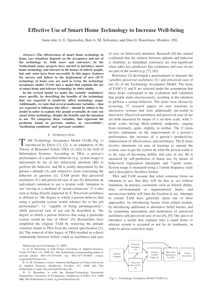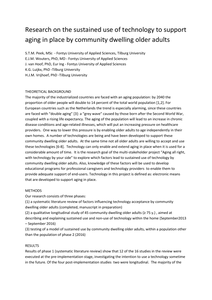To evaluate a broad variety of technology already present in the houses of older persons, and to discover factors encouraging and discouraging the purchase and use of these devices.
DOCUMENT

Advanced technology is a primary solution for the shortage of care professionals and increasing demand for care, and thus acceptance of such technology is paramount. This study investigates factors that increase use of advanced technology during elderly care, focusing on current use of advanced technology, factors that influence its use, and care professionals’ experiences with the use. This study uses a mixed-method design. Logfiles were used (longitudinal design) to determine current use of advanced technology, questionnaires assessed which factors increase such use, and in-depth interviews were administered to retrieve care professionals’ experiences. Findings suggest that 73% of care professionals use advanced technology, such as camera monitoring, and consult clients’ records electronically. Six of nine hypotheses tested in this study were supported, with correlations strongest between performance expectancy and attitudes toward use, attitudes toward use and satisfaction, and effort expectancy and performance expectancy. Suggested improvements for advanced technology include expanding client information, adding report functionality, solving log-in problems, and increasing speed. Moreover, the quickest way to increase acceptance is by improving performance expectancy. Care professionals scored performance expectancy of advanced technology lowest, though it had the strongest effect on attitudes toward the technology.
DOCUMENT

Technology in general, and assistive technology in particular, is considered to be a promising opportunity to address the challenges of an aging population. Nevertheless, in health care, technology is not as widely used as could be expected. In this chapter, an overview is given of theories and models that help to understand this phenomenon. First, the design of (assistive) technologies will be addressed and the importance of human-centered design in the development of new assistive devices will be discussed. Also theories and models are addressed about technology acceptance in general. Specific attention will be given to technology acceptance in healthcare professionals, and the implementation of technology within healthcare organizations. The chapter will be based on the state of the art of scientific literature and will be illustrated with examples from our research in daily practice considering the different perspectives of involved stakeholders.
LINK
Over the last two decades, institutions for higher education such as universities and colleges have rapidly expanded and as a result have experienced profound changes in processes of research and organization. However, the rapid expansion and change has fuelled concerns about issues such as educators' technology professional development. Despite the educational value of emerging technologies in schools, the introduction has not yet enjoyed much success. Effective use of information and communication technologies requires a substantial change in pedagogical practice. Traditional training and learning approaches cannot cope with the rising demand on educators to make use of innovative technologies in their teaching. As a result, educational institutions as well as the public are more and more aware of the need for adequate technology professional development. The focus of this paper is to look at action research as a qualitative research methodology for studying technology professional development in HE in order to improve teaching and learning with ICTs at the tertiary level. The data discussed in this paper have been drawn from a cross institutional setting at Fontys University of Applied Sciences, The Netherlands. The data were collected and analysed according to a qualitative approach.
DOCUMENT

The effectiveness of smart home technology in home care situations depends on the acceptance and use of the technology by both users and end-users. In the Netherlands many projects have started to introduce smart home technology and telecare in the homes of elderly people, but only some have been successful. In this paper, features for success and failure in the deployment of new (ICT) technology in home care are used to revise the technology acceptance model (TAM) into a model that explains the use of smart home and telecare technology by older adults. In the revised model we make the variable 'usefulness' more specific, by describing the benefits of the technology that are expected to positively affect technology usage. Additionally, we state that several moderator variables - that are expected to influence this effect - should be added to the model in order to explain why people eventually do (not) use smart home technology, despite the benefits and the intention to use. We categorize these variables, that represent the problems found in previous studies, in 'accessibility', 'facilitating conditions' and 'personal variables'.
DOCUMENT

Although aging in place is preferred by most older adults and policy makers, there are situations in which aging in place can be challenging. This is particularly true in the case of cognitive decline, which has a profound influence on all aspects of life, including the use of technology
DOCUMENT
Introduction: Ambient intelligence technologies are a means to support ageing-in-place by monitoring clients in the home. In this study, monitoring is applied for the purpose of raising an alarm in an emergency situation, and thereby, providing an increased sense of safety and security. Apart from these technological solutions, there are numerous environmental interventions in the home environment that can support people to age-in-place. The aim of this study was to investigate the needs and motives, related to ageing-in-place, of the respondents receiving ambient intelligence technologies, and to investigate whether, and how, these technologies contributed to aspects of ageing-in-place. Methodology: This paper presents the results of a qualitative study comprised of interviews and observations of technology and environmental interventions in the home environment among 18 community-dwelling older adults with a complex demand for care. These respondents had a prototype of the Unattended Autonomous Surveillance system, an example of ambient intelligence technology, installed in their homes as a means to age-in-place. The UAS-system offers a large range of functionalities, including mobility monitoring, voice response, fire detection, as well as wandering detection and prevention, which can be installed in different configurations. Results: The respondents had various motives to use ambient intelligence technologies to support ageing-in-place. The most prominent reason was to improve the sense of safety and security, in particular, in case of fall incidents, when people were afraid not to be able to use their existing emergency response systems. The ambient intelligence technologies were initially seen as a welcome addition to strategies already adopted by the respondents, including a variety of home modifications and assistive devices. The systems tested increased the sense of safety and security and helped to postpone institutionalisation. Respondents came up with a set of specifications in terms of the operation and the design of the technology. False alarms were also regarded as a sign that the ambient intelligence technology is functioning. Moreover, a good integration of the new technologies in the provision of health care is indispensable, and installation should be done in an acceptable and unobtrusive manner. Ambient intelligence technologies can contribute to an increased safety and security at home. The technologies alone offer no all encompassing solution as home care and additional environmental interventions are still needed to support ageing-in-place. Results of the study are used to further improve the ambient intelligence technologies and their implementation.
DOCUMENT
Purpose: This is a position paper describing the elements of an international framework for assistive techhnology provision that could guide the development of policies, systems and service delivery procedures across the world. It describes general requirements, quality criteria and possible approaches that may help to enhance the accessibility of affordable and high quality assistive technology solutions. Materials and methods: The paper is based on the experience of the authors, an analysis of the existing literature and the inputs from many colleagues in the field of assistive technology provision. It includes the results of discussions of an earlier version of the paper during an international conference on the topic in August 2017. Results and conclusion: The paper ends with the recommendation to develop an international standard for assistive technology provision. Such a standard can have a major impact on the accessibility of AT for people with disabilities. The paper outlines some the key elements to be included in a standard.
DOCUMENT

The temporal dimension of acceptance is under-researched in technology acceptance research. Yet, people’s perceptions on technology use may change over time when gaining user experiences. Our 6-month home study deploying an interactive robot provides insight into the long-term use of use interactive technology in a domestic environment. We present a phased framework for the acceptance of interactive technology in domestic environments. Based on 97 interviews obtained from 21 participants living in different household types, the results provide an initial validation of our phased framework for long-term acceptance showing that acceptance phases are linked to certain user experiences which evolve over time when people gain experience with the technology. Involving end users in the early stages of development helps researchers understand the cultural and social contexts of acceptance and enables developers to apply this gained knowledge into their future designs.
DOCUMENT

-
DOCUMENT
